Jiangxia Cao
Kwai Keye-VL Technical Report
Jul 02, 2025Abstract:While Multimodal Large Language Models (MLLMs) demonstrate remarkable capabilities on static images, they often fall short in comprehending dynamic, information-dense short-form videos, a dominant medium in today's digital landscape. To bridge this gap, we introduce \textbf{Kwai Keye-VL}, an 8-billion-parameter multimodal foundation model engineered for leading-edge performance in short-video understanding while maintaining robust general-purpose vision-language abilities. The development of Keye-VL rests on two core pillars: a massive, high-quality dataset exceeding 600 billion tokens with a strong emphasis on video, and an innovative training recipe. This recipe features a four-stage pre-training process for solid vision-language alignment, followed by a meticulous two-phase post-training process. The first post-training stage enhances foundational capabilities like instruction following, while the second phase focuses on stimulating advanced reasoning. In this second phase, a key innovation is our five-mode ``cold-start'' data mixture, which includes ``thinking'', ``non-thinking'', ``auto-think'', ``think with image'', and high-quality video data. This mixture teaches the model to decide when and how to reason. Subsequent reinforcement learning (RL) and alignment steps further enhance these reasoning capabilities and correct abnormal model behaviors, such as repetitive outputs. To validate our approach, we conduct extensive evaluations, showing that Keye-VL achieves state-of-the-art results on public video benchmarks and remains highly competitive on general image-based tasks (Figure 1). Furthermore, we develop and release the \textbf{KC-MMBench}, a new benchmark tailored for real-world short-video scenarios, where Keye-VL shows a significant advantage.
RecCoT: Enhancing Recommendation via Chain-of-Thought
Jun 26, 2025Abstract:In real-world applications, users always interact with items in multiple aspects, such as through implicit binary feedback (e.g., clicks, dislikes, long views) and explicit feedback (e.g., comments, reviews). Modern recommendation systems (RecSys) learn user-item collaborative signals from these implicit feedback signals as a large-scale binary data-streaming, subsequently recommending other highly similar items based on users' personalized historical interactions. However, from this collaborative-connection perspective, the RecSys does not focus on the actual content of the items themselves but instead prioritizes higher-probability signals of behavioral co-occurrence among items. Consequently, under this binary learning paradigm, the RecSys struggles to understand why a user likes or dislikes certain items. To alleviate it, some works attempt to utilize the content-based reviews to capture the semantic knowledge to enhance recommender models. However, most of these methods focus on predicting the ratings of reviews, but do not provide a human-understandable explanation.
LLM-Alignment Live-Streaming Recommendation
Apr 07, 2025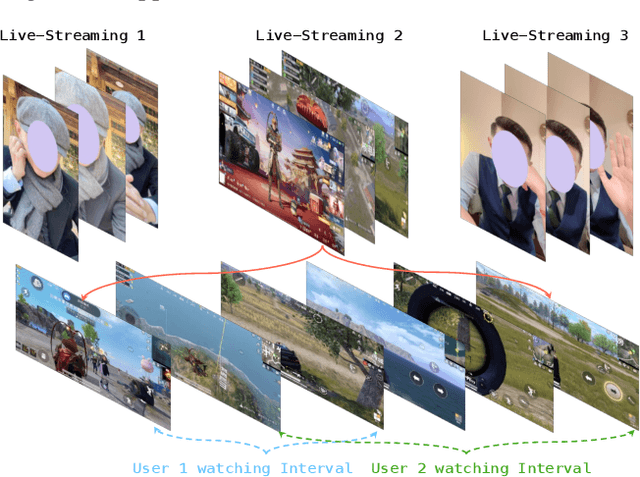



Abstract:In recent years, integrated short-video and live-streaming platforms have gained massive global adoption, offering dynamic content creation and consumption. Unlike pre-recorded short videos, live-streaming enables real-time interaction between authors and users, fostering deeper engagement. However, this dynamic nature introduces a critical challenge for recommendation systems (RecSys): the same live-streaming vastly different experiences depending on when a user watching. To optimize recommendations, a RecSys must accurately interpret the real-time semantics of live content and align them with user preferences.
Federated Mixture-of-Expert for Non-Overlapped Cross-Domain Sequential Recommendation
Mar 17, 2025Abstract:In the real world, users always have multiple interests while surfing different services to enrich their daily lives, e.g., watching hot short videos/live streamings. To describe user interests precisely for a better user experience, the recent literature proposes cross-domain techniques by transferring the other related services (a.k.a. domain) knowledge to enhance the accuracy of target service prediction. In practice, naive cross-domain techniques typically require there exist some overlapped users, and sharing overall information across domains, including user historical logs, user/item embeddings, and model parameter checkpoints. Nevertheless, other domain's user-side historical logs and embeddings are not always available in real-world RecSys designing, since users may be totally non-overlapped across domains, or the privacy-preserving policy limits the personalized information sharing across domains. Thereby, a challenging but valuable problem is raised: How to empower target domain prediction accuracy by utilizing the other domain model parameters checkpoints only? To answer the question, we propose the FMoE-CDSR, which explores the non-overlapped cross-domain sequential recommendation scenario from the federated learning perspective.
FARM: Frequency-Aware Model for Cross-Domain Live-Streaming Recommendation
Feb 13, 2025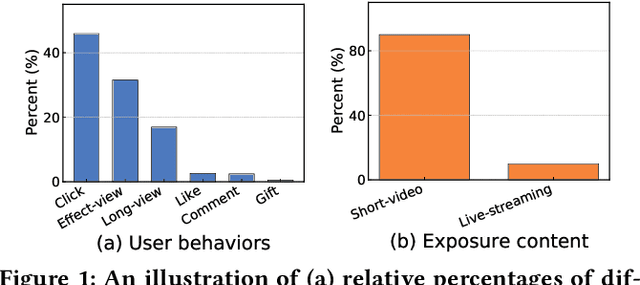

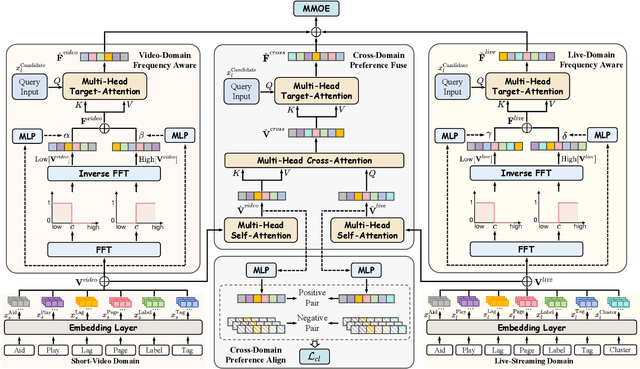

Abstract:Live-streaming services have attracted widespread popularity due to their real-time interactivity and entertainment value. Users can engage with live-streaming authors by participating in live chats, posting likes, or sending virtual gifts to convey their preferences and support. However, the live-streaming services faces serious data-sparsity problem, which can be attributed to the following two points: (1) User's valuable behaviors are usually sparse, e.g., like, comment and gift, which are easily overlooked by the model, making it difficult to describe user's personalized preference. (2) The main exposure content on our platform is short-video, which is 9 times higher than the exposed live-streaming, leading to the inability of live-streaming content to fully model user preference. To this end, we propose a Frequency-Aware Model for Cross-Domain Live-Streaming Recommendation, termed as FARM. Specifically, we first present the intra-domain frequency aware module to enable our model to perceive user's sparse yet valuable behaviors, i.e., high-frequency information, supported by the Discrete Fourier Transform (DFT). To transfer user preference across the short-video and live-streaming domains, we propose a novel preference align before fuse strategy, which consists of two parts: the cross-domain preference align module to align user preference in both domains with contrastive learning, and the cross-domain preference fuse module to further fuse user preference in both domains using a serious of tailor-designed attention mechanisms. Extensive offline experiments and online A/B testing on Kuaishou live-streaming services demonstrate the effectiveness and superiority of FARM. Our FARM has been deployed in online live-streaming services and currently serves hundreds of millions of users on Kuaishou.
ChorusCVR: Chorus Supervision for Entire Space Post-Click Conversion Rate Modeling
Feb 12, 2025



Abstract:Post-click conversion rate (CVR) estimation is a vital task in many recommender systems of revenue businesses, e.g., e-commerce and advertising. In a perspective of sample, a typical CVR positive sample usually goes through a funnel of exposure to click to conversion. For lack of post-event labels for un-clicked samples, CVR learning task commonly only utilizes clicked samples, rather than all exposed samples as for click-through rate (CTR) learning task. However, during online inference, CVR and CTR are estimated on the same assumed exposure space, which leads to a inconsistency of sample space between training and inference, i.e., sample selection bias (SSB). To alleviate SSB, previous wisdom proposes to design novel auxiliary tasks to enable the CVR learning on un-click training samples, such as CTCVR and counterfactual CVR, etc. Although alleviating SSB to some extent, none of them pay attention to the discrimination between ambiguous negative samples (un-clicked) and factual negative samples (clicked but un-converted) during modelling, which makes CVR model lacks robustness. To full this gap, we propose a novel ChorusCVR model to realize debiased CVR learning in entire-space.
LiveForesighter: Generating Future Information for Live-Streaming Recommendations at Kuaishou
Feb 10, 2025Abstract:Live-streaming, as a new-generation media to connect users and authors, has attracted a lot of attention and experienced rapid growth in recent years. Compared with the content-static short-video recommendation, the live-streaming recommendation faces more challenges in giving our users a satisfactory experience: (1) Live-streaming content is dynamically ever-changing along time. (2) valuable behaviors (e.g., send digital-gift, buy products) always require users to watch for a long-time (>10 min). Combining the two attributes, here raising a challenging question for live-streaming recommendation: How to discover the live-streamings that the content user is interested in at the current moment, and further a period in the future?
CRM: Retrieval Model with Controllable Condition
Dec 18, 2024

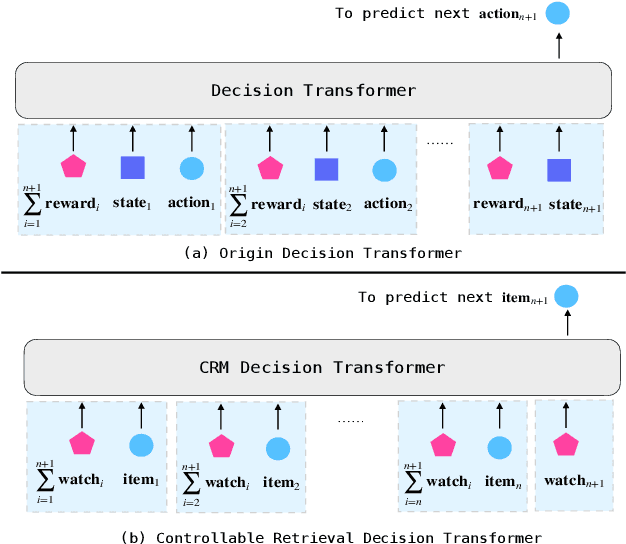
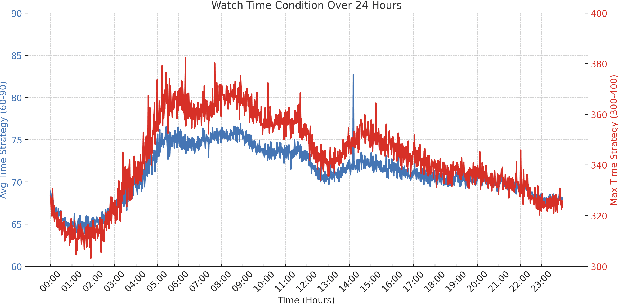
Abstract:Recommendation systems (RecSys) are designed to connect users with relevant items from a vast pool of candidates while aligning with the business goals of the platform. A typical industrial RecSys is composed of two main stages, retrieval and ranking: (1) the retrieval stage aims at searching hundreds of item candidates satisfied user interests; (2) based on the retrieved items, the ranking stage aims at selecting the best dozen items by multiple targets estimation for each item candidate, including classification and regression targets. Compared with ranking model, the retrieval model absence of item candidate information during inference, therefore retrieval models are often trained by classification target only (e.g., click-through rate), but failed to incorporate regression target (e.g., the expected watch-time), which limit the effectiveness of retrieval. In this paper, we propose the Controllable Retrieval Model (CRM), which integrates regression information as conditional features into the two-tower retrieval paradigm. This modification enables the retrieval stage could fulfill the target gap with ranking model, enhancing the retrieval model ability to search item candidates satisfied the user interests and condition effectively. We validate the effectiveness of CRM through real-world A/B testing and demonstrate its successful deployment in Kuaishou short-video recommendation system, which serves over 400 million users.
QARM: Quantitative Alignment Multi-Modal Recommendation at Kuaishou
Nov 18, 2024



Abstract:In recent years, with the significant evolution of multi-modal large models, many recommender researchers realized the potential of multi-modal information for user interest modeling. In industry, a wide-used modeling architecture is a cascading paradigm: (1) first pre-training a multi-modal model to provide omnipotent representations for downstream services; (2) The downstream recommendation model takes the multi-modal representation as additional input to fit real user-item behaviours. Although such paradigm achieves remarkable improvements, however, there still exist two problems that limit model performance: (1) Representation Unmatching: The pre-trained multi-modal model is always supervised by the classic NLP/CV tasks, while the recommendation models are supervised by real user-item interaction. As a result, the two fundamentally different tasks' goals were relatively separate, and there was a lack of consistent objective on their representations; (2) Representation Unlearning: The generated multi-modal representations are always stored in cache store and serve as extra fixed input of recommendation model, thus could not be updated by recommendation model gradient, further unfriendly for downstream training. Inspired by the two difficulties challenges in downstream tasks usage, we introduce a quantitative multi-modal framework to customize the specialized and trainable multi-modal information for different downstream models.
KuaiFormer: Transformer-Based Retrieval at Kuaishou
Nov 15, 2024Abstract:In large-scale content recommendation systems, retrieval serves as the initial stage in the pipeline, responsible for selecting thousands of candidate items from billions of options to pass on to ranking modules. Traditionally, the dominant retrieval method has been Embedding-Based Retrieval (EBR) using a Deep Neural Network (DNN) dual-tower structure. However, applying transformer in retrieval tasks has been the focus of recent research, though real-world industrial deployment still presents significant challenges. In this paper, we introduce KuaiFormer, a novel transformer-based retrieval framework deployed in a large-scale content recommendation system. KuaiFormer fundamentally redefines the retrieval process by shifting from conventional score estimation tasks (such as click-through rate estimate) to a transformer-driven Next Action Prediction paradigm. This shift enables more effective real-time interest acquisition and multi-interest extraction, significantly enhancing retrieval performance. KuaiFormer has been successfully integrated into Kuaishou App's short-video recommendation system since May 2024, serving over 400 million daily active users and resulting in a marked increase in average daily usage time of Kuaishou users. We provide insights into both the technical and business aspects of deploying transformer in large-scale recommendation systems, addressing practical challenges encountered during industrial implementation. Our findings offer valuable guidance for engineers and researchers aiming to leverage transformer models to optimize large-scale content recommendation systems.
 Add to Chrome
Add to Chrome Add to Firefox
Add to Firefox Add to Edge
Add to Edge